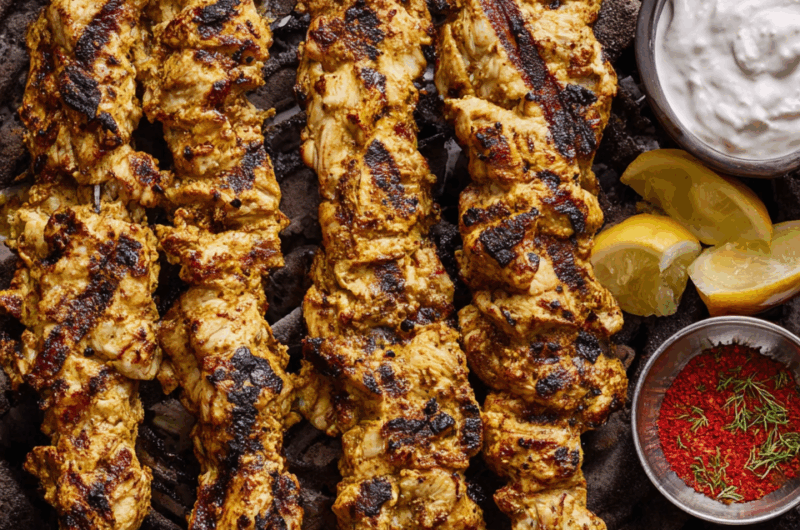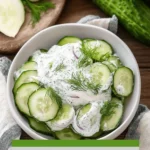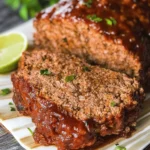Juicy, tender, and spiced with fragrant Mediterranean herbs, these Turkish Chicken Kebabs bring a taste of the Bosphorus straight to your backyard grill. With a yogurt-based marinade packed with garlic, cumin, paprika, and lemon, every bite is bursting with flavor. The grill sears the outside to a golden char while locking in moisture, making them irresistibly succulent.
Perfect for summer BBQs, cozy dinners, or weeknight meals that feel special without the fuss, this dish is as versatile as it is delicious. Serve these skewers with flatbread, fresh salads, or rice pilaf for a full Turkish-inspired feast. Once you try them, they’ll quickly become a favorite in your grilling rotation.
Full Recipe:
-
1 cup plain yogurt
-
4 cloves garlic, minced
-
2 tablespoons olive oil
-
2 tablespoons lemon juice
-
2 tablespoons ketchup
-
1 teaspoon red pepper flakes
-
1 teaspoon salt
-
1 teaspoon ground cumin
-
1/2 teaspoon freshly ground black pepper
-
1/2 teaspoon paprika
-
1/4 teaspoon ground cinnamon
-
2 pounds boneless skinless chicken thighs, halved
Directions:
-
In a large bowl, whisk together yogurt, garlic, olive oil, lemon juice, ketchup, red pepper flakes, salt, cumin, black pepper, paprika, and cinnamon until well combined.
-
Add the halved chicken thighs to the marinade, making sure each piece is well coated. Cover with plastic wrap and refrigerate for 2 to 8 hours.
-
Preheat an outdoor grill to medium-high heat and lightly oil the grates.
-
Using 2 skewers per kebab, thread the marinated chicken tightly to form thick “logs.”
-
Place skewers on the hot grill and cook undisturbed for 3 to 4 minutes until they naturally release from the grill. Flip and cook another 3 to 4 minutes. Continue turning and cooking until chicken is cooked through, about 6 more minutes.
-
Internal temperature should reach 165°F (74°C) before removing from grill. Let rest for a couple of minutes before serving.
Prep Time: 15 minutes | Cooking Time: 13 minutes | Total Time: 8 hours (with marination)
Kcal: 275 kcal per serving | Servings: 6 servings
Introduction to Turkish Chicken Kebabs
Turkish Chicken Kebabs are more than just a meal — they are a cultural expression of centuries-old culinary traditions rooted in the rich, diverse cuisine of Turkey. With bold spices, fragrant marinades, and a grilling technique that locks in flavor, this dish is beloved both in Turkish households and around the globe. Unlike many Western-style grilled chicken dishes that rely heavily on dry rubs or sauces applied post-cooking, Turkish Chicken Kebabs rely on a deeply flavorful yogurt-based marinade that tenderizes the meat while infusing it with warm, aromatic spices. This results in juicy, succulent chicken skewers with a slight tang, subtle heat, and beautiful char marks from the grill.
Cultural Significance and Historical Roots
Kebabs hold a special place in Turkish culinary history, tracing their roots back to the Ottoman Empire. While the word “kebab” is broadly used throughout the Middle East and South Asia to describe skewered and grilled meat, Turkey’s version has its own distinct characteristics. In particular, chicken kebabs (known as “Tavuk Şiş” in Turkish) are a staple in both street food markets and home kitchens. The tradition of cooking meat over an open flame is deeply tied to nomadic Turkic tribes, who traveled across Central Asia and brought their methods to the Anatolian region. Over time, those techniques evolved into regional specialties, with chicken skewers becoming one of the most accessible and versatile interpretations.
The Power of the Yogurt Marinade
A defining characteristic of Turkish Chicken Kebabs is the use of a yogurt-based marinade. This isn’t just for taste—it’s also science. Yogurt contains natural lactic acids and enzymes that gently break down the protein fibers in meat. When chicken thighs are marinated for several hours, this enzymatic action tenderizes the meat without making it mushy, creating a texture that is moist and delicate once cooked. The yogurt also helps lock in the spices, ensuring that every bite is packed with flavor. In this particular recipe, ingredients like garlic, cumin, red pepper flakes, paprika, black pepper, and even a touch of cinnamon create a well-rounded, slightly smoky and earthy flavor profile. The acidity from the lemon juice in the marinade not only enhances flavor but also plays a role in further tenderizing the meat.
Why Chicken Thighs Are the Preferred Cut
Though you could technically use chicken breast for kebabs, this recipe favors chicken thighs, and for good reason. Thigh meat is inherently more flavorful and fattier than chicken breast, which means it’s less likely to dry out over a hot grill. The darker meat retains its juiciness even after being exposed to direct heat, making it perfect for skewering and grilling. The extra moisture in chicken thighs also allows them to absorb more of the marinade, amplifying the overall taste and mouthfeel of the final dish.
Grilling Technique and Skewering Tips
One of the secrets to the perfect Turkish Chicken Kebab is the double-skewering technique. Threading each kebab with two skewers ensures stability, making it easier to turn the meat on the grill without pieces spinning or falling apart. This method also helps the chicken cook more evenly. Grilling over medium-high heat is ideal for these kebabs. You want to create a nice sear on the outside while ensuring the inside reaches a safe temperature of at least 165°F (74°C). Another tip: allow the meat to sear undisturbed for the first few minutes to prevent sticking. Only turn the skewers once the meat naturally releases from the grill grates, which will help maintain its integrity and beautiful char lines.
Flavor Profile and Aroma Experience
Turkish Chicken Kebabs deliver a complex yet approachable flavor that appeals to a wide range of palates. The garlic and cumin create a savory backbone, while red pepper flakes introduce a gentle heat that doesn’t overpower. Paprika contributes a mild smokiness and vibrant color, while cinnamon adds a unique warmth that lingers subtly in the background. When grilled, the yogurt marinade caramelizes slightly, forming a flavorful crust that enhances the overall eating experience. The scent of these spices grilling over flame evokes a sensory journey through Turkish bazaars, where spice vendors and street food stalls fill the air with intoxicating aromas.
Serving Suggestions and Traditional Sides
Traditionally, Turkish Chicken Kebabs are served with flatbreads such as lavash or pita, along with a variety of fresh, vibrant side dishes. Some classic pairings include shepherd’s salad (çoban salatası) made with tomatoes, cucumbers, onions, and parsley dressed in lemon and olive oil; or pilav, a simple rice dish infused with butter and herbs. A drizzle of garlicky yogurt sauce or a spoonful of ezme (a spicy tomato-pepper relish) also complements the kebabs perfectly. For an authentic presentation, serve the kebabs directly on the skewers atop a platter garnished with grilled vegetables like peppers, onions, and tomatoes. This approach not only looks visually appealing but also echoes the street food style common in Turkish cuisine.
Health and Nutritional Considerations
While these kebabs are rich in flavor, they are also relatively healthy. Using a yogurt-based marinade instead of heavy oils or creams keeps the calorie count low while adding protein and probiotics. Chicken thighs, though slightly higher in fat than breast meat, are still a lean source of protein and offer more iron and zinc. Grilling is also a low-fat cooking method, allowing excess fat to drip away during the cooking process. For those following low-carb or ketogenic diets, this dish is ideal, especially when served with grilled veggies or low-carb sides. It’s also naturally gluten-free, provided the sides and sauces you use don’t contain wheat products.
Popular Variations and Regional Twists
The beauty of Turkish Chicken Kebabs lies in their adaptability. While this recipe uses a particular spice blend, many regions across Turkey add their own twists. Some include sumac for tang, others add Aleppo pepper for deeper heat, and some even incorporate mint or thyme for herbal notes. If you’re feeling adventurous, try adding a tablespoon of tomato paste or a spoonful of pomegranate molasses to the marinade for extra depth. You can also experiment with grilled accompaniments like eggplant slices, zucchini, or mushrooms to vary the texture and flavor on your kebab plate.
Why This Dish Is Great for Entertaining
If you’re hosting a barbecue or dinner party, Turkish Chicken Kebabs are an excellent centerpiece. Not only can you prep the meat in advance (allowing it to marinate overnight), but grilling them is quick and straightforward. The visual impact of skewers sizzling on the grill, paired with their aromatic spices, creates an enticing ambiance that will draw your guests in. Moreover, kebabs are inherently individual portions, making serving simple and stress-free. Just pair them with communal side dishes and you’ve got a meal that encourages sharing and conversation.
A Dish That Transcends Borders
Though deeply Turkish in origin, this kebab recipe is truly global in its appeal. Whether you’re enjoying them in a bustling Istanbul eatery or cooking them on a backyard grill in North America, the flavors transcend geography. In fact, versions of this dish appear in many cuisines — from Middle Eastern shish tawook to Greek souvlaki — each reflecting a local adaptation of skewered chicken. This universality makes Turkish Chicken Kebabs not just a meal, but a delicious example of culinary diplomacy, uniting people through shared flavors and cooking traditions.
Conclusion: Why You’ll Keep Coming Back to This Recipe
In a world full of complex recipes and time-consuming cooking methods, Turkish Chicken Kebabs offer a refreshing balance of simplicity, flavor, and cultural richness. The marinade does most of the work, infusing the chicken with layers of taste while tenderizing it to perfection. The grilling process is quick, and the result is a stunningly satisfying dish that feels both comforting and exotic at the same time. Whether you’re cooking for family, friends, or simply treating yourself, this is one recipe that delivers on every level—taste, texture, nutrition, and ease of preparation. Add it to your regular rotation and you’ll understand why it’s stood the test of time in Turkish kitchens and beyond.








